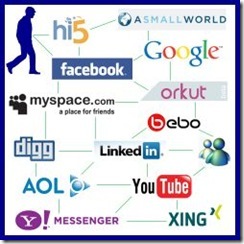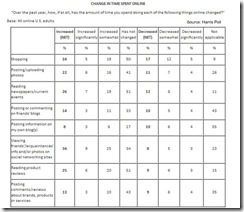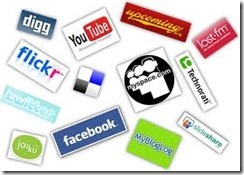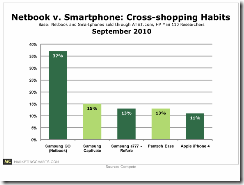 US online adults were most likely to say they have increased their viewing of friends’ photos and information on social networks out of a wide variety of online activities during the past year, according to results of a new Harris Poll.
US online adults were most likely to say they have increased their viewing of friends’ photos and information on social networks out of a wide variety of online activities during the past year, according to results of a new Harris Poll.
1/3 Have Increased SocNet Viewing

About one-third (34%) of online US adults say they have increased their viewing of friends’ photos and information on social networks either significantly or somewhat in the past year. This was the highest percentage combined response for increasing any of the eight activities presented to respondents (multiple answers were accepted).
Reading newspapers/current events followed at a distant second with a combined 26% saying they have increased this online activity either significantly or somewhat in the past year. However, somewhat mitigating this low rate of increased online activity is an often lower rate of decreased online activity.
For example, only a combined 8% of online adults say they have decreased their viewing of friends’ photos and information on social networks either significantly or somewhat in the past year. A full 23% say this activity is not applicable and 34% say it has not changed.
Results are similar for most other activities, with the not changed rate of many hovering above 50%. Shopping had the highest combined rate of decrease (17%).
Interestingly, a leading 55% of respondents say posting information on their own blogs is not applicable, and 43% say posting or commenting on friends’ blogs is not applicable, reflecting the shrinking popularity of blogs among US online users.
SocNet Users, Young, Educated More Likely to Increase Online Activity
Almost across the board, social media users, younger and better educated respondents are more likely to say they have increased an online activity in the past year. The difference between social media users and non-social media users is most pronounced in rates of viewing friends’ photos and information on social networks, posting and commenting information on friends’ or own blogs, and posting comments/reviews about brands, products or services.
Conversely, non-social media users were more likely than social media users to have increased reading newspapers/current events, the only online activity where they surpassed social media users.
Blogging, reading newspapers and review posting were the only areas where increase rates were not highest among 18-to-34-year-olds. Posting information on your own blog, reading newspapers and posting comments/reviews had the highest rates of increase among 35-to-44-year-olds, posting/commenting on friends’ blogs had the highest rate of increase among 45-to-54-year-olds.
While there was some variety among what age brackets were the second-most-likely to have increased an online activity, 55-plus respondents had the lowest response rate in any area except shopping, where their increase rate of 22% beat 45-to-54-year-olds (20%) and tied 35-to-44-year-olds.
Meanwhile, respondents with a high school education or less were the least likely to have increased all eight online activities. Those with a college degree or more had higher increase rates than those with some college in every activity except posting comments on friends’ blogs and posting reviews.
3 in 10 Use SocNets for Product Reviews
Only a combined 28% of online adults say they have used social media to rant or rave about a company, brand or product. However, a combined 80% of respondents agree strongly or somewhat they give up part of their privacy by participating in social media, and a combined 73% agree strongly or somewhat social media only reveals a snapshot, rather than a full portrait, of who they are.
6 in 10 SocNet Users Feel More Connected
Six in 10 (59%) of social network users say they feel more connected to people now than previously, according to another recent Harris Poll. That figure is highest among 18-to-34-year-olds (63%) and females (61%). Similar percentages (58% overall, 63% of 18-to-34-year-olds, 60% of females) say they keep in touch with friends more now than in the past.
Social network users say this even as majorities admit they recently have had less face-to-face contact with friends (55%) and know what’s going on with many of their friends and acquaintances, but don’t interact with them personally or individually (60%). Negative emotional impact of this loss of personal contact appears small, as only 32% of social network users feel lonelier now than previously.


































